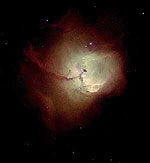Citations
>>Mad
about Monica
Who
says a Republican in the White House means no more presidential-intern
talk? Lauren
G. Berlant, professor of English language & literature,
believes there's more to be said. In the anthology Our Monica,
Ourselves: The Clinton Affair and the National Interest (New
York University Press, 2001), Berlant and co-editor Lisa Duggan
of New York University offer retrospective assessments of the
Monica Lewinsky affair by 24 journalists, scholars, and activists.
Essays range from a wry riff on Linda Tripp jokes to a historical
analysis linking President Clinton's impeachment to the history
of the right wing since the New Deal.

>>Let
there be silicon and iron
Until
recently astronomers have assumed that silicon was produced more
abundantly than iron in the early lifetimes of young, distant
galaxies. But new findings from the Hubble Space Telescope suggest
that both of those heavy elements may have been produced in comparable
amounts-a possibility that will help researchers better understand
star formation. The findings, presented by senior research associate
Daniel Welty, SM'79, PhD'85, at the June 4 American
Astronomical Society meeting, are based on analyses of gas and
dust in the Small Magellanic Cloud, 200,000 light years away.
Welty's co-authors are astronomy & astrophysics professor
Lewis M. Hobbs and Donald
G. York, PhD'71, the Horace B. Horton professor in
astronomy & astrophysics.
>>Do
herbs and surgery mix?
Why and when patients should stop using herbal medications before
undergoing surgery depends on the herb being used, say anesthesia
and critical care assistant professor Chun-Su
Yuan, professor Jonathan
Moss, and senior resident Michael
K. Ang-Lee in the July 11 Journal of the American
Medical Association. Their study assesses interactions between
eight commonly used herbs (echinacea, ephedra, garlic, ginkgo,
ginseng, kava, St. John's wort, and valerian), anesthesia, and
surgery, suggesting ways to reduce risks.
>>Mirror,
mirror
In the 1960s British theoretical physicist Nevill Mott described
how glass and other amorphous substances can function as semiconductors
by changing between electrically conductive (metallic) and insulating
(nonmetallic) states. Physicists quickly figured out that lacing
certain simple compounds with hydrogen can turn shiny metal conductors
into clear insulators. But how to turn them back again? By flashing
the compounds-in this case, hydrides of the rare earth elements
yttrium and lanthanum-with ultraviolet light, reports Thomas
F. Rosenbaum, professor of physics, in the June 4 Physical
Review Letters. Such UV-switchable mirrors are intriguing
both in their basic physics and for possible applications in optical
computing and fiber-optic network switching, where researchers
seek tricks for controlling light with light.
>>Few
grim prognoses
In only 37 percent of cases are physicians willing to give terminally
ill cancer patients their best estimate of how long the patient
might expect to live. So says a study by Nicholas
Christakis, associate professor of medicine and sociology,
and Elizabeth
B. Lamont, SM'00, internal medicine instructor, in
the July 19 Annals of Internal Medicine. In 40 percent
of cases the doctors said they would knowingly provide an inaccurate
estimate of survival time-usually an overestimate-and in 23 percent
the doctors said they would refuse to provide any estimate. Physicians
want to give patients hope, but the authors say withholding bad
news prevents patients from making informed choices.
>>Rare
neonatal diabetes gene
A
complete deficiency of glucokinase, an enzyme that helps regulate
blood-sugar levels, is the culprit in a rare form of neonatal
diabetes, according to a report in the May 24 New England Journal
of Medicine. Co-authored by Graeme
I. Bell, professor of biochemistry & molecular
biology, the study links the genetic defect to permanent neonatal
diabetes mellitus, which occurs in one in 400,000 live births.
-S.A.S.

![]()
